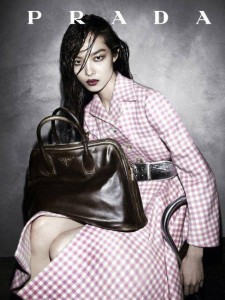
![]()
Advertisement on the left taken from Vogue January 2013, advertisement on the right taken from ICON magazine 2015.
These two advertisements were taken from women’s magazines in China, the one on the right was taken from ICON magazine a Singaporean fashion publication that has been locally established throughout China and the one on the left was taken from Chinese Vogue. In their article, Frith and Yeng describe the difference between locally based publications and multinational publications with a foothold in China. In their estimation, while both groups of publishers rely on advertisement, local publications rely more heavily on mass circulation, while international publications such as Vogue rely on advertisement to secure revenue. Owing to this difference, many local publications have a slightly less high end quality to them, specifically they cater to lower to middle class women while international publications cater to higher class women (1). The difference in these two advertisements, when considered in this context, demonstrates the notion that beauty is a class issue in China and a woman’s ability to conform to beauty standards depends on her ability to afford self alterations.
sound statement
Content of the advertisement: The advertisement on the right shows a product that alters skin appearance making it appear younger and more pale. The advertisement is cluttered with information about price and how to obtain the product, which presumes that people to whom this advertisement is targeted, lower to middle class Chinese women, would seek this product out and use it. why? This is in direct contrast to the advertisement from Vogue, which provides no information about the product, in fact it is not clear exactly what product (the dress or the bag) the advertisement features. The name of the company figures prominently at the top of the advertisement but there is no price, store location or phone number. This suggests that this advertisement is not directed at clients who will expressly seek out the product and use it, but rather it is selling a way of life or a persona. In other words, the advertisement presumes that upper class have everything they could need to be beautiful and now are just looking to personify a way of life associated with this beauty.
Choice of models: The difference in the two models further demonstrates the connection between class and beauty. The model on the left appears both younger, specifically because of her “baby face”, and more pale than the one on the right. This fits in with the obsession with paleness and the notions of nennu and shunu that seem to be central to the Chinese notion of beauty. The simple fact that the advertisement targeted towards wealthier women displays the two main ideals of Chinese beauty while the advertisement targeted towards lower to middle class women seems to be striving for these ideals without actually attaining them demonstrates that beauty and wealth are strongly connected, particularly when self-alteration seems to be such a widespread beauty ritual in China.
please elaborate “self-alteration?”
In conclusion, the difference in the layout and content of the advertisments as well as the models themselves, clearly demonstrates the trend that while lower and middle class women seem to constantly strive to meet beauty ideals with various products, upper class women have the resources alter themselves and meet these standards, making beauty a fundamentally class based issue.
(1)Transnational and cultural flows: An analysis of women’s magazines in China, Frith and Feng. Chinese Journal of Communication. 2(2) July 2009, 159-173.
both statement and structure are clear. The issue of class could be further investigated.
